Protect Kids and Pets
Plants serve us in many ways — they beautify the environment, release oxygen into the air and yield fruit for the table. Yet, we need to be aware that poisonous plants are everywhere. More than 700 species of plants located in the United States and Canada can cause illness or death in humans. It’s important to identify the dangerous plants inside your home, in your garden, and in nearby woods and parks. Some ornamental shrubs and trees and a variety of wild plants common in yards, woods, swamps and fields can be dangerous.
When moving to a new home, it’s smart to identify the plants in the landscape, and it's wise to ask about potential toxicity when buying new plants for your home and yard. If you are uncertain of a plant's identity, take it to a nursery or florist for identification. It’s a good idea to label plants in the home and throw away leaves as they die and fall. Mushrooms in the yard need to be picked and disposed of as soon as possible. Tell children not to eat them. Gardening is often a family activity. Until you use seeds and bulbs, store them safely out of reach of children. And children should not pick any vegetables or fruit without adult supervision.
Basic Tips
By following some basic steps, you can help protect your children and pets from being harmed by toxic plants:
- Know the names of poisonous plants.
- Show babysitters and grandparents where to find the list of plant names.
- Keep dangerous plants out of reach of children and pets.
- Teach children never to touch or eat plant parts.
- Teach children that sucking nectar from flowers is unsafe.
- Never let children suck on jewelry made from decorative beans or seeds.
- Store labeled bulbs and seeds safely out of the reach of children and pets.
- Never collect wild herbs to eat or brew as tea, unless you are professionally trained to identify them.
- Don’t burn toxic plants. Smoke from poison oak, poison ivy and other toxic plants can irritate your eyes, nose, throat and lungs.
Emergency Action
If you, or someone you know has eaten a poisonous plant, contact a physician or the Poison Control Center at 1-800-442-6305 immediately. If the victim is choking and cannot breathe, dial 911. Remove any plant parts from the mouth as quickly as possible and try to determine the following:
- Can you describe the plant, including the size, shape and arrangement of the leaves?
- What part of the plant was eaten?
- What kind of fruit was eaten? Berries? Nuts? Can you describe it in detail — color, firmness, juiciness, etc?
- Where is the plant growing?
If you are told to go to an emergency room for treatment, take the plant or a portion of the plant with you. Take more than a single leaf or berry. Answer all questions to the best of your knowledge, and follow the advice given by the Poison Control Center or physician. Do not induce vomiting in a child without consulting a physician or the Poison Control Center. In some cases, vomiting may affect a child's heart rate.
Each case needs individual evaluation and The Poison Control Center's recommendations will vary with the amount and time of ingestion. By dialing 1-800-222-1222, Texas residents have access to a network of nurses, pharmacists, paramedics and physicians who have extensive education, training and expertise in the field of toxicology.
If necessary, the staff may refer callers to the nearest hospital and assist in the person’s initial treatment and follow-up care.
Note: It's the dose that makes the poison. Just one bite of some plants can be harmful, while with others, it may take eating the entire plant. And remember, a plant in Pennsylvania may be less — or more — harmful than the same plant in Texas. So before you go vacation, it’s a good idea to learn about native plants.
For more information on plants and tips on poison-proofing your home, visit www.poisoncontrol.org.
